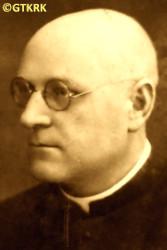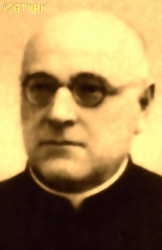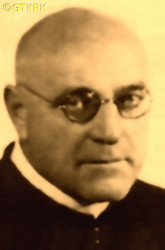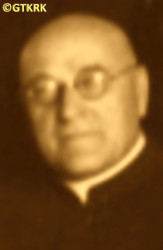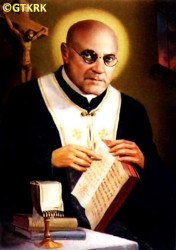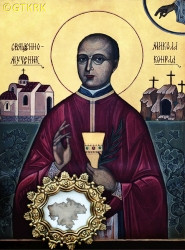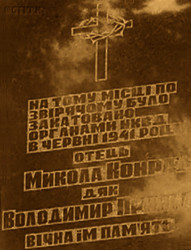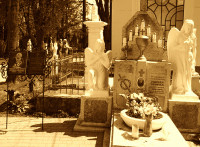Roman Catholic
St Sigismund parish
05-507 Słomczyn
85 Wiślana Str.
Konstancin deanery
Warsaw archdiocese, Poland
full list:
displayClick to display full list

searchClick to search full list by categories
wyświetlKliknij by wyświetlić pełną listę po polsku

szukajKliknij by przeszukać listę wg kategorii po polsku

Martyrology of the clergy — Poland
XX century (1914 – 1989)
personal data
religious status
blessed
surname
KONRAD
forename(s)
Nicholas (pl. Mikołaj)
beatification date
27.06.2001more on
www.swzygmunt.knc.pl
[access: 2013.05.19]

the RC Pope John Paul IImore on
en.wikipedia.org
[access: 2014.09.21]
function
eparchial priest
creed
Ukrainian Greek Catholic GCmore on
en.wikipedia.org
[access: 2013.05.19]
diocese / province
Lviv GC archeparchymore on
en.wikipedia.org
[access: 2013.05.19]
academic distinctions
professsor ordinarius
Doctor of Philosophy
Doctor of Theology
nationality
Ukrainian
date and place
of death
26.06.1941

Stradchtoday: Ivano‐Frankove hrom., Yavoriv rai., Lviv obl., Ukraine
more on
uk.wikipedia.org
[access: 2022.08.05]
details of death
At the beginning of World War I 1914‐1918, due to the Russian offensive, which led to the defeat of the Austro–Hungarian Army and the Russian occupation of almost all of Galicia (including Ternopil), left Ternopil and moved to Uherské Hradiště in Czechia. There ministered among Ukrainian refugees, even after the Russian defeat at the Battle of Gorlice in 05.1915 and the re–occupation of Galicia by Austria–Hungary.
Then became a chaplain in the Gmünd POW camp in Austria.
After returning to Galicia in 1918, during the Polish–Ukrainian war of 1918‐1919, interned by the Polish government in the the POWs and Internees Camp No. 1, in the Kraków district of Dąbie and POWs and Internees Camp No. 1 Strzałkowo — as a member of the municipal board of Trembowli established by the Ukrainians (the so‐called West Ukrainian People's Republic ZUNR). Released in 1919‐1920.
After German and Russian invasion of Poland in 09.1939 and start of the World War II, after start of Russian occupation, after German attack on 22.06.1941 of their erstwhile ally, Russians, captured — with his cantor, Wladimir Pryjma — by a band of Russian soldiers retreating before advancing Germans.
Tortured (had an arm broken) and murdered (had bayonet's wounds) in a nearby forest.
cause of death
mass murder
perpetrators
Russians
sites and events
06.1941 massacres (NKVD)Click to display the description, Ribbentrop‐MolotovClick to display the description, Pius XI's encyclicalsClick to display the description, OJiI No. 1 StrzałkowoClick to display the description, OJiI No. 1 DąbieClick to display the description, Polish‐Ukrainian war of 1918‐1919Click to display the description
date and place
of birth
16.05.1876

Strusivtoday: Mykulyntsi hrom., Ternopil rai., Ternopil obl., Ukraine
more on
en.wikipedia.org
[access: 2023.03.02]
parents
KONRAD Joseph
🞲 ?, ? — 🕆 ?, ?

ŻUTKOWSKA Mary
🞲 ?, ? — 🕆 ?, ?
presbyter (holy orders)
ordination
1899

positions held
1939 – 1941
parish priest — Stradchtoday: Ivano‐Frankove hrom., Yavoriv rai., Lviv obl., Ukraine
more on
uk.wikipedia.org
[access: 2022.08.05] ⋄ Assumption of the Blessed Virgin Mary GC parish ⋄ Yanivtoday: Ivano‐Frankove, Ivano‐Frankove hrom., Yavoriv rai., Lviv obl., Ukraine
more on
en.wikipedia.org
[access: 2022.12.13] GC deanery
till 1939
dean — Lvivtoday: Lviv urban hrom., Lviv rai., Lviv obl., Ukraine
more on
en.wikipedia.org
[access: 2022.01.16] ⋄ Department of Philosophy, Greek Catholic Theological Academy
1937 – 1939
full professor — Lvivtoday: Lviv urban hrom., Lviv rai., Lviv obl., Ukraine
more on
en.wikipedia.org
[access: 2022.01.16] ⋄ sociology and ancient and contemporary philosophy, Greek Catholic Theological Academy
c. 1931 – 1939
councillor — Lvivtoday: Lviv urban hrom., Lviv rai., Lviv obl., Ukraine
more on
en.wikipedia.org
[access: 2022.01.16] ⋄ Archeparchial Consistory (i.e. Curia) — also: clerk (c. 1932), censor of religious books (c. 1932‐1939)
c. 1931 – 1939
pro‐synodal judge — Lvivtoday: Lviv urban hrom., Lviv rai., Lviv obl., Ukraine
more on
en.wikipedia.org
[access: 2022.01.16] ⋄ Archeparchy's Metropolitan Court ⋄ Lviv GC archeparchy
1930 – 1937
lecturer — Lvivtoday: Lviv urban hrom., Lviv rai., Lviv obl., Ukraine
more on
en.wikipedia.org
[access: 2022.01.16] ⋄ sociology and ancient and contemporary philosophy, Greek Catholic Theological Academy — also: diocesan youth pastor (c. 1932)
1921 – 1930
prefect — Ternopiltoday: Ternopil urban hrom., Ternopil rai., Ternopil obl., Ukraine
more on
en.wikipedia.org
[access: 2020.11.20] ⋄ Ukrainian Pedagogical Society’s Private Gymnasium for Girls with Ruthenian as the language of instruction ⋄ Nativity of Christ GC parish ⋄ Ternopiltoday: Ternopil urban hrom., Ternopil rai., Ternopil obl., Ukraine
more on
en.wikipedia.org
[access: 2020.11.20] GC deanery
1919 – 1920
prefect — Berezhanytoday: Berezhany urban hrom., Ternopil rai., Ternopil obl., Ukraine
more on
en.wikipedia.org
[access: 2020.11.15] ⋄ State Gymnasium with Ruthenian as the language of instruction ⋄ Holy Trinity GC parish ⋄ Berezhanytoday: Berezhany urban hrom., Ternopil rai., Ternopil obl., Ukraine
more on
en.wikipedia.org
[access: 2020.11.15] GC deanery
1918 – 1919
parish priest — Terebovlyatoday: Terebovlya urban hrom., Ternopil rai., Ternopil obl., Ukraine
more on
en.wikipedia.org
[access: 2020.11.20] ⋄ St Nicholas the Wonderworker GC parish ⋄ Terebovlyatoday: Terebovlya urban hrom., Ternopil rai., Ternopil obl., Ukraine
more on
en.wikipedia.org
[access: 2020.11.20] GC deanery
till c. 1918
chaplain — Gmündtoday: Gmünd dist., Lower Austria state, Austria
more on
en.wikipedia.org
[access: 2023.11.24] ⋄ POW/internee camp — also: catechist and lecturer at gymnasium–level training courses
from c. 1914
priest — Uherské Hradištětoday: Uherské Hradiště r. mun., Uherské Hradiště dist., Zlín reg., Czechia
more on
en.wikipedia.org
[access: 2023.11.24]
c. 1910 – 1914
prefect — Ternopiltoday: Ternopil urban hrom., Ternopil rai., Ternopil obl., Ukraine
more on
en.wikipedia.org
[access: 2020.11.20] ⋄ Imperial Higher Gymnasium ⋄ Nativity of Christ GC parish ⋄ Ternopiltoday: Ternopil urban hrom., Ternopil rai., Ternopil obl., Ukraine
more on
en.wikipedia.org
[access: 2020.11.20] GC deanery — also: inspector/commissioner of religious education in public schools of the deanery (c. 1914)
c. 1909
parish priest — Bilyi Kamintoday: Zolochiv urban hrom., Zolochiv rai., Lviv obl., Ukraine
more on
en.wikipedia.org
[access: 2022.09.31] ⋄ Holy Trinity GC parish ⋄ Oleskotoday: Busk urban hrom., Zolochiv rai., Lviv obl., Ukraine
more on
en.wikipedia.org
[access: 2020.11.20] GC deanery — also: inspector/commissioner of religious education in public schools of the deanery
1902 – c. 1907
prefect — Ternopiltoday: Ternopil urban hrom., Ternopil rai., Ternopil obl., Ukraine
more on
en.wikipedia.org
[access: 2020.11.20] ⋄ Imperial Higher Gymnasium (c. 1907), professional faculty school and women(c. 1907), 7‐grade higher education „real” school ⋄ Nativity of Christ GC parish ⋄ Ternopiltoday: Ternopil urban hrom., Ternopil rai., Ternopil obl., Ukraine
more on
en.wikipedia.org
[access: 2020.11.20] GC deanery
c. 1902
prefect — Terebovlyatoday: Terebovlya urban hrom., Ternopil rai., Ternopil obl., Ukraine
more on
en.wikipedia.org
[access: 2020.11.20] ⋄ St Nicholas the Wonderworker GC parish ⋄ Terebovlyatoday: Terebovlya urban hrom., Ternopil rai., Ternopil obl., Ukraine
more on
en.wikipedia.org
[access: 2020.11.20] GC deanery
c. 1900 – c. 1902
prefect — Zolochivtoday: Zolochiv urban hrom., Zolochiv rai., Lviv obl., Ukraine
more on
en.wikipedia.org
[access: 2021.12.19] ⋄ professional faculty schools for men and women ⋄ Our Lord's Resurrection GC parish ⋄ Zolochivtoday: Zolochiv urban hrom., Zolochiv rai., Lviv obl., Ukraine
more on
en.wikipedia.org
[access: 2021.12.19] GC deanery
till 1899
PhD student — Rometoday: Rome prov., Lazio reg., Italy
more on
en.wikipedia.org
[access: 2021.12.18] ⋄ theology, „Angelicum” [i.e. Lat. Pontificia Universitas Studiorum a Sancto Thoma Aquinate in Urbe (Eng. Pontifical University of St Thomas Aquinas) (today) / Lat. Pontificium Institutum Internationale (Eng. Pontifical International Institute) (1926‐1963) / Lat. Pontificium Collegium (Eng. Pontifical College) (1906‐1926) / Lat. Collegium (Eng. College) (until 1906)]
till 1895
PhD student — Rometoday: Rome prov., Lazio reg., Italy
more on
en.wikipedia.org
[access: 2021.12.18] ⋄ philosophy, „Angelicum” [i.e. Lat. Pontificia Universitas Studiorum a Sancto Thoma Aquinate in Urbe (Eng. Pontifical University of St Thomas Aquinas) (today) / Lat. Pontificium Institutum Internationale (Eng. Pontifical International Institute) (1926‐1963) / Lat. Pontificium Collegium (Eng. Pontifical College) (1906‐1926) / Lat. Collegium (Eng. College) (until 1906)]
student — Rometoday: Rome prov., Lazio reg., Italy
more on
en.wikipedia.org
[access: 2021.12.18] ⋄ philosophy and theology, „Angelicum” [i.e. Lat. Pontificia Universitas Studiorum a Sancto Thoma Aquinate in Urbe (Eng. Pontifical University of St Thomas Aquinas) (today) / Lat. Pontificium Institutum Internationale (Eng. Pontifical International Institute) (1926‐1963) / Lat. Pontificium Collegium (Eng. Pontifical College) (1906‐1926) / Lat. Collegium (Eng. College) (until 1906)]
author of i.a. „Dr I. Franka: A poem about the creation of the world”, Lviv, 1905; „Modern mentality and Catholicism”, Lviv, 1934; „Nationalism and Catholicism”, Lviv, 1934; „Essay on the history of ancient philosophy”, Lviv, 1934; „Corporate structure of citizenship”, Lviv, 1935; „Main directions of modern sociology. Liberalism”, Lviv, 1936
married — three children
sites and events
descriptions
06.1941 massacres (NKVD): After German attack of Russian‐occupied Polish territory and following that of Russia itself, before a panic escape, Russians murdered — in accordance with the genocidal order issued on 24.06.1941 by the Russian interior minister Lawrence Beria to murder all prisoners (formally „sentenced” for „counter‐revolutionary activities”, „anti‐Russian acts”, sabotage and diversion, and political prisoners „in custody”), held in NKVD‐run prisons in Russian occupied Poland, Lithuania, Latvia and Estonia — c. 40,000‐50,000 prisoners. In addition Russians murdered many thousands of victims arrested after German attack regarding them as „enemies of people” — those victims were not even entered into prisons’ registers. Most of them were murdered in massacres in the prisons themselves, the others during so‐called „death marches” when the prisoners were driven out east. After Russians departure and start of German occupation a number of spontaneous pogroms of Jews took place. Many Jews collaborated with Russians and were regarded as co‐responsible for prison massacres. (more on: en.wikipedia.orgClick to attempt to display webpage
[access: 2021.12.19])
Ribbentrop‐Molotov: Genocidal Russian‐German alliance pact between Russian leader Joseph Stalin and German leader Adolf Hitler signed on 23.08.1939 in Moscow by respective foreign ministers, Mr. Vyacheslav Molotov for Russia and Joachim von Ribbentrop for Germany. The pact sanctioned and was the direct cause of joint Russian and German invasion of Poland and the outbreak of the World War II in 09.1939. In a political sense, the pact was an attempt to restore the status quo ante before 1914, with one exception, namely the „commercial” exchange of the so‐called „Kingdom of Poland”, which in 1914 was part of the Russian Empire, fore Eastern Galicia (today's western Ukraine), in 1914 belonging to the Austro‐Hungarian Empire. Galicia, including Lviv, was to be taken over by the Russians, the „Kingdom of Poland” — under the name of the General Governorate — Germany. The resultant „war was one of the greatest calamities and dramas of humanity in history, for two atheistic and anti‐Christian ideologies — national and international socialism — rejected God and His fifth Decalogue commandment: Thou shall not kill!” (Abp Stanislav Gądecki, 01.09.2019). The decisions taken — backed up by the betrayal of the formal allies of Poland, France and Germany, which on 12.09.1939, at a joint conference in Abbeville, decided not to provide aid to attacked Poland and not to take military action against Germany (a clear breach of treaty obligations with Poland) — were on 28.09.1939 slightly altered and made more precise when a treaty on „German‐Russian boundaries and friendship” was agreed by the same murderous signatories. One of its findings was establishment of spheres of influence in Central and Eastern Europe and in consequence IV partition of Poland. In one of its secret annexes agreed, that: „the Signatories will not tolerate on its respective territories any Polish propaganda that affects the territory of the other Side. On their respective territories they will suppress all such propaganda and inform each other of the measures taken to accomplish it”. The agreements resulted in a series of meeting between two genocidal organization representing both sides — German Gestapo and Russian NKVD when coordination of efforts to exterminate Polish intelligentsia and Polish leading classes (in Germany called «Intelligenzaktion», in Russia took the form of Katyń massacres) where discussed. Resulted in deaths of hundreds of thousands of Polish intelligentsia, including thousands of priests presented here, and tens of millions of ordinary people,. The results of this Russian‐German pact lasted till 1989 and are still in evidence even today. (more on: en.wikipedia.orgClick to attempt to display webpage
[access: 2015.09.30])
Pius XI's encyclicals: Facing the creation of two totalitarian systems in Europe, which seemed to compete with each other, though there were more similarities than contradictions between them, Pope Pius XI issued in 03.1937 (within 5 days) two encyclicals. In the „Mit brennender Sorge” (Eng. „With Burning Concern”) published on 14.03.1938, condemned the national socialism prevailing in Germany. The Pope wrote: „Whoever, following the old Germanic‐pre‐Christian beliefs, puts various impersonal fate in the place of a personal God, denies the wisdom of God and Providence […], whoever exalts earthly values: race or nation, or state, or state system, representatives of state power or other fundamental values of human society, […] and makes them the highest standard of all values, including religious ones, and idolizes them, this one […] is far from true faith in God and from a worldview corresponding to such faith”. On 19.03.1937, published „Divini Redemptoris” (Eng. „Divine Redeemer”), in which criticized Russian communism, dialectical materialism and the class struggle theory. The Pope wrote: „Communism deprives man of freedom, and therefore the spiritual basis of all life norms. It deprives the human person of all his dignity and any moral support with which he could resist the onslaught of blind passions […] This is the new gospel that Bolshevik and godless communism preaches as a message of salvation and redemption of humanity”… Pius XI demanded that the established human law be subjected to the natural law of God , recommended the implementation of the ideal of a Christian state and society, and called on Catholics to resist. Two years later, National Socialist Germany and Communist Russia came together and started World War II. (more on: www.vatican.vaClick to attempt to display webpage
[access: 2023.05.28], www.vatican.vaClick to attempt to display webpage
[access: 2023.05.28])
OJiI No. 1 Strzałkowo: POWs and Internees Camp No. 1 (11.07.1919‐02.1920 called POW Camp No. 1), in Strzałkowo, right at the former border between the German Empire and the Russian Empire — one of the internment camps during the final phase of the Polish–Ukrainian War of 1918‐1919 and the Polish–Russian War of 1919‐1921 — for prisoners captured by the Polish Army, i.e. mainly Russians and Ukrainians. Founded on 12.05.1919, on the site of a former internment camp of the German Imperial Army for prisoners of the Imperial Russian Army during World War I. At its peak, the camp, designed for c. 20,000 prisoners, held c. 30,000 people, including — after the ceasefire in the Polish–Russian war of 18.10.1920 — c. 4,000 soldiers and their families from the Ukrainian People's Army, fighting on the side of Poland. About half of the prisoners worked in the fields or at transshipment stations. The conditions in the camp were terrible. The prisoners arrived there in poor physical condition, and the low food rations (all over Poland the food conditions were very difficult), especially for those who did not work, led to starvation. Epidemics of Spanish flu (i.e. influenza), typhus and dysentery broke out constantly. In total, c. 7,600 people died, among them c. 6,200 Russians and 500 prisoners from World War I. Liquidated on 31.08.1924 — many released Russians, after returning to Bolshevik Russia, were sent to Russian slave labor camps, i.e. gulags. (more on: pl.wikipedia.orgClick to attempt to display webpage
[access: 2025.03.07])
OJiI No. 1 Dąbie: POWs and Internees Camp No. 1, in the Kraków district of Dąbie — one of the internment camps, during the Polish–Ukrainian war of 1918‐1919, the Polish–Czech conflict of 1919 and the Polish–Russian war of 1919‐1921 — for prisoners captured by the Polish Army, i.e. Ukrainians, Czechs, Russians. Established in 11.1918 on the site of a POW camp of the former Austro–Hungarian Empire. At its peak, in 03.1920, the camp held 4,987 people. Epidemics of typhus and dysentery broke out in the camp several times: e.g. in 12.1918, 02.1919. During the three years of the camp's existence, 1,104 people died there. Liquidated on 06.12.1921. (more on: dabiehistoria.blogspot.comClick to attempt to display webpage
[access: 2025.03.07])
Polish‐Ukrainian war of 1918‐1919: One of the wars for borders of the newly reborn Poland. At the end of 1918 on the former Austro‐Hungarian empire’s territory, based on the Ukrainian military units of the former Austro‐Hungarian army, Ukrainians waged war against Poland. In particular attempted to create foundation of an independent state and attacked Lviv. Thanks to heroic stance of Lviv inhabitants, in particular young generation of Poles — called since then Lviv eaglets — the city was recaptured by Poles and for a number of months successfully defended against furious Ukrainian attacks. In 1919 Poland — its newly created army — pushed Ukrainian forces far to the east and south, regaining control over its territory. (more on: en.wikipedia.orgClick to attempt to display webpage
[access: 2017.05.20])
sources
personal:
www.swzygmunt.knc.plClick to attempt to display webpage
[access: 2013.05.19], pl.wikipedia.orgClick to attempt to display webpage
[access: 2013.05.19], lesiaromanchuk.comClick to attempt to display webpage
[access: 2019.12.26]
original images:
catholicnews.org.uaClick to attempt to display webpage
[access: 2019.12.26], lesiaromanchuk.comClick to attempt to display webpage
[access: 2019.12.26], walkbyfaithtolive.comClick to attempt to display webpage
[access: 2019.12.26], esu.com.uaClick to attempt to display webpage
[access: 2019.12.26], lesiaromanchuk.comClick to attempt to display webpage
[access: 2019.12.26], live-christ.comClick to attempt to display webpage
[access: 2019.12.26], stradch.comClick to attempt to display webpage
[access: 2019.12.26], www.youtube.comClick to attempt to display webpage
[access: 2014.07.11], wikigogo.orgClick to attempt to display webpage
[access: 2014.07.11]
LETTER to CUSTODIAN/ADMINISTRATOR
If you have an Email client on your communicator/computer — such as Mozilla Thunderbird, Windows Mail or Microsoft Outlook, described at WikipediaPatrz:
en.wikipedia.org, among others — try the link below, please:
LETTER to CUSTODIAN/ADMINISTRATORClick and try to call your own Email client
If however you do not run such a client or the above link is not active please send an email to the Custodian/Administrator using your account — in your customary email/correspondence engine — at the following address:

giving the following as the subject:
MARTYROLOGY: KONRAD Nicholas
To return to the biography press below:
 Click to return to biography
Click to return to biography








